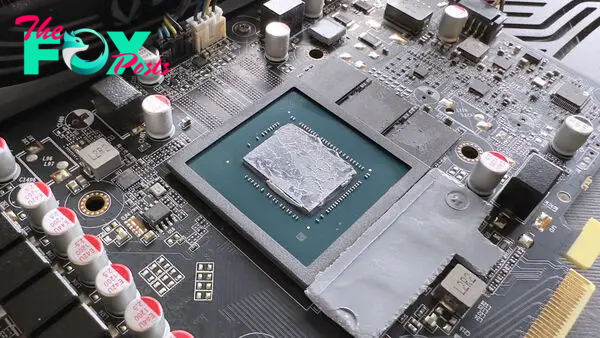Trendy graphics playing cards use a lot of energy and all of it’s became warmth. So should you’re paying many tons of of {dollars} for a strong GPU, you’d count on no expense to be spared on the cooling system. It seems that for a lot of Nvidia RTX 40-series distributors, the expense is being spared and low-cost, poorly utilized thermal paste is resulting in scorching excessive hotspot temperatures and efficiency degradation over time.
That is the conclusion {hardware} tester Igor’s Lab has come to after testing a number of GeForce RTX playing cards, analysing temperatures and efficiency, and discovering that the thermal paste utilized by many graphics card distributors will not be solely sub-standard for the job however can also be poorly utilized.
I’ve 4 RTX 40-series playing cards in my workplace (RTX 4080 Tremendous, 4070 Ti, and two 4070s) and all of them have fairly excessive hotspots—the best temperature recorded by a person thermal sensor within the die. Within the case of the 4080 Tremendous, it is round 11 °C greater than the typical temperature of the chip. I took it aside to use some first rate high quality thermal paste and found the same state of affairs to that discovered by Igor’s Lab.
Within the house of some months, the factory-applied paste had separated and unfold out, leaving simply an oily movie behind, and some patches of the thermal compound itself. I checked the opposite playing cards and located that they have been all in the same state.
Igor’s Lab examined the thermal paste used on a brand-new RTX 4080 and located it to be fairly skinny in nature, resulting from giant portions of low-cost silicone oil getting used, together with zinc oxide filler. There was a lot of floor aluminium oxide (the fabric that gives the precise thermal switch) nevertheless it was fairly coarse, resulting in the paste separating fairly simply.
Eradicating the factory-installed paste from one other RTX 4080 graphics card, Igor’s Lab utilized a extra applicable quantity of a high-quality paste and found that it lowered the hotspot temperature by almost 30 °C.
Nevertheless it’s not simply in regards to the hotspots. Low cost, poorly utilized thermal paste will trigger the efficiency of a graphics card to degrade over time as a result of GPUs decrease clock speeds once they attain their thermal limits. PC fans are most likely very comfy with changing a CPU’s thermal paste frequently nevertheless it’s not a easy course of with graphics playing cards.
When you’ve handed over the higher a part of $1,000 to your graphics card, you would be justified in pondering that this should not be a crucial job for years—definitely not inside just a few months of getting the cardboard.
In my case, altering the paste on the RTX 4080 Tremendous did not enhance the hotspot delta (so I’ll strive some PTM7950 in some unspecified time in the future) however the total die temperature did drop by just a few levels. I am frequently monitoring all 4 playing cards to see if the temperatures begin to creep up however I additionally really feel that I actually should not have to do that.
Whereas Nvidia enjoys big margins on its GPUs, graphics card distributors aren’t fairly so fortunate, however they don’t seem to be so small that spending just a few extra {dollars} on higher thermal paste is not going to bankrupt the corporate.
Thoughts you, if all of them began utilizing PTM7950, then none of this may be a difficulty—the playing cards would run cooler and would keep that means for for much longer. The one downside then is that you just’d hear the coil whine over the diminished fan noise.
Ah, PC gaming isn’t straightforward, is it?




































